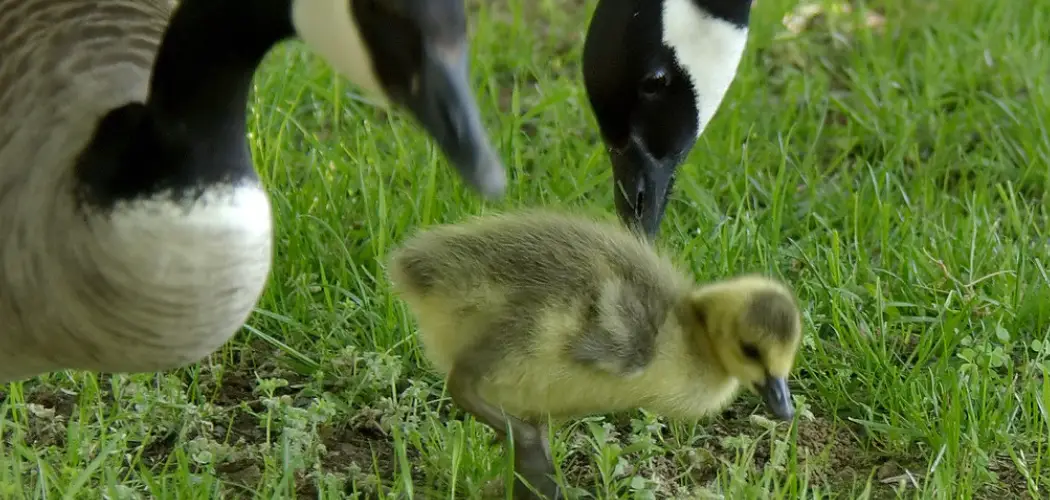Raising goslings, young geese, is both a rewarding and challenging endeavor that requires careful planning and dedication. In Introduction to Gosling Rearing, we will explore the basics of how to raise goslings, highlighting the initial steps and considerations needed to start on the right foot.
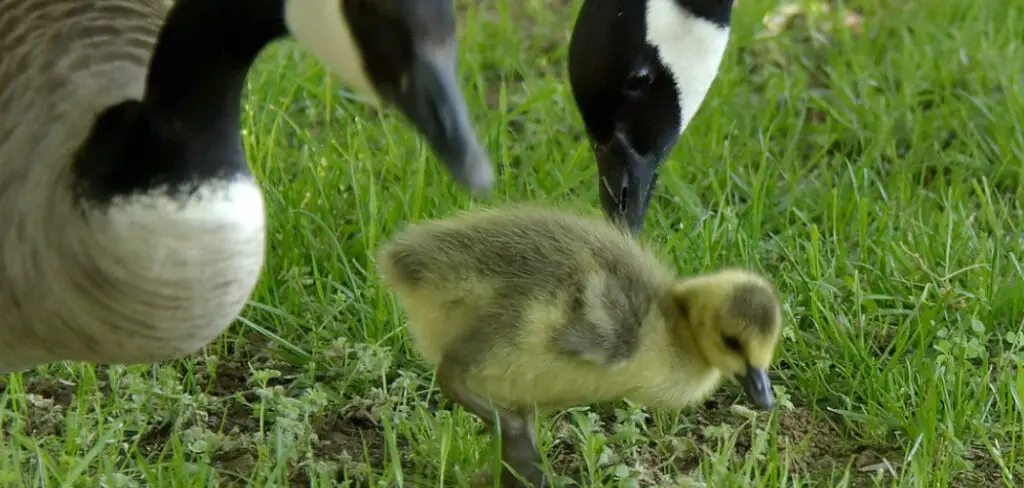
The Overview of Goslings as Young Geese section will detail the characteristics, needs, and special considerations these young birds require, from their dietary to environmental requirements. Understanding the Importance of Proper Care and Management Practices for Healthy Gosling Development is crucial. Proper care includes providing a safe and nurturing environment, appropriate nutrition, and regular health checks.
This comprehensive guide is designed to equip you with the knowledge to raise happy, healthy goslings, covering every aspect from their arrival to eventual maturity.
Planning and Preparation
Planning and preparation are pivotal in ensuring your goslings’ well-being and healthy development. A thorough approach towards setting up their living environment, accumulating essential supplies, and establishing health and safety measures can significantly contribute to their thriving.
A. Housing Requirements
The first step in Housing Requirements involves creating a suitable brooding area that offers adequate space, warmth, and protection against predators. This area should be spacious enough for the goslings to move around freely without overcrowding, allowing for approximately 2-3 square feet per gosling.
Ensuring the brooding area is well-insulated and free from drafts is crucial in maintaining a comfortable temperature for the goslings. Additionally, the brooding space should be secure from predators, with solid walls and a sturdy roof, to prevent any potential threats from harming the goslings.
B. Equipment and Supplies
When it comes to Equipment and Supplies, readiness is key. The essential items include brooders, which provide a source of heat; feeders designed for easy access without contamination; and waterers that supply clean water at all times.
A high-quality starter feed specific to goslings, rich in nutrients, is fundamental for their growth and development. Choosing equipment that is easy to clean and maintain is important, as hygiene plays a crucial role in the health of the goslings.
C. Health and Safety Measures
Health and Safety Measures focus on implementing biosecurity protocols to prevent the spread of disease and ensure the well-being of the goslings. This includes strict control measures such as footbaths, sanitizing equipment regularly, and limiting access to the brooding area to prevent the introduction of pathogens.
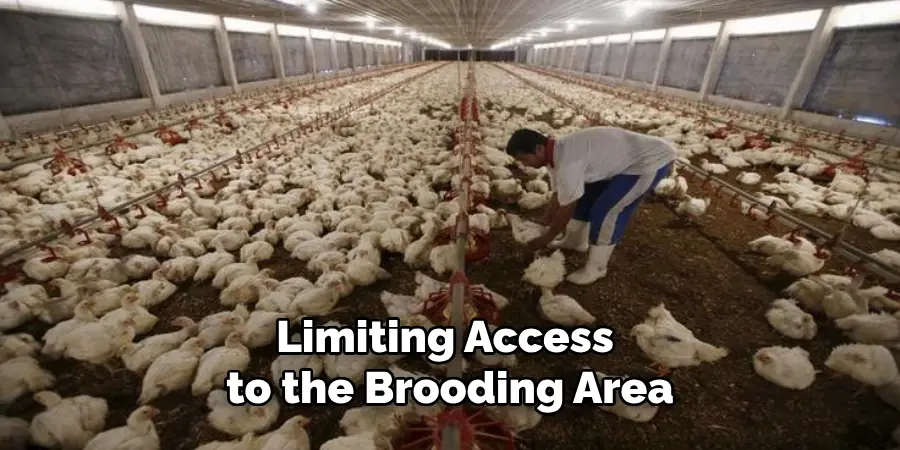
Monitoring the health of the goslings closely, looking out for signs of distress or illness, and providing prompt veterinary care when needed are essential practices. Establishing a routine vaccination program can also contribute significantly to the goslings’ robust health.
By carefully focusing on these planning and preparation steps, you lay a solid foundation for successfully rearing goslings.
How to Raise Goslings: Brooding and Temperature Management
Ensuring the right brooding and temperature conditions is essential for newly hatched goslings’ healthy growth and comfort. From the moment they arrive, paying attention to their warmth needs will set the ground for their overall well-being and development.
A. Optimal Temperature
The initial brooding temperature should be carefully maintained around 90-95°F (32-35°C). This range mimics the warmth and security that goslings would naturally receive from their mother.
Maintaining this temperature is crucial during the first week of life, as it supports the body’s development and aids in the transition from egg to external environment. Use a reliable thermometer to monitor the temperature consistently, ensuring it remains within this optimal range.
B. Heat Source
Achieving a consistent and appropriate brooding temperature can be efficiently managed by using heat lamps or brooders. These devices are designed to provide a uniform heat distribution, ensuring that no gosling is left feeling cold. It’s imperative to set up the heat source so that it covers the entire brooding area, allowing goslings to move in and out of the warmth as they wish.
Furthermore, always ensure there is no risk of overheating or accidental burns by positioning the heat source at a safe distance above the brooding area and securing it firmly to prevent any falls.

C. Gradual Temperature Reduction
As goslings begin to grow and feather out, their requirement for external heat sources diminishes. Gradually lowering the brooding temperature by a few degrees each week is necessary to adapt to their changing needs. This decrease should be done carefully, monitoring the goslings’ behavior for signs they are either too cold (huddling together under the heat source) or too warm (moving away and spreading out).
By the time they are 4 to 6 weeks old, depending on environmental conditions and their feather development, they may no longer need supplemental heat.
Managing the brooding environment with careful consideration of temperature and comfort ensures the goslings’ survival and promotes a healthy start to their growth cycle. This phase is fundamental in preparing them for the next stages of development, gradually transitioning them towards a more independent lifestyle.
How to Raise Goslings: Nutrition and Feeding
Proper nutrition is fundamental to the health and development of goslings. Understanding and implementing the right feeding practices can significantly impact their growth, immunity, and overall well-being.
A. Starter Feed
Initially, goslings should be provided with a high-quality commercial starter feed that is formulated specifically for their needs. This feed typically contains about 20-24% protein, which is essential for their rapid growth and development. The high protein content supports the development of muscles, feathers, and other vital organs. It is crucial to ensure that the starter feed is fresh and free from mold or contaminants to prevent health issues.
B. Feeding Schedule
Goslings thrive on a schedule of frequent feedings of small meals throughout the day. This approach mimics their natural foraging behavior and ensures a steady intake of nutrients for optimal growth. From the first day, ensure that goslings have unlimited access to the starter feed.
They should also always have access to fresh, clean water; it is essential for digestion and overall health. Monitor the feed consumption closely and regularly adjust the amount as they grow to avoid wastage and ensure cleanliness.
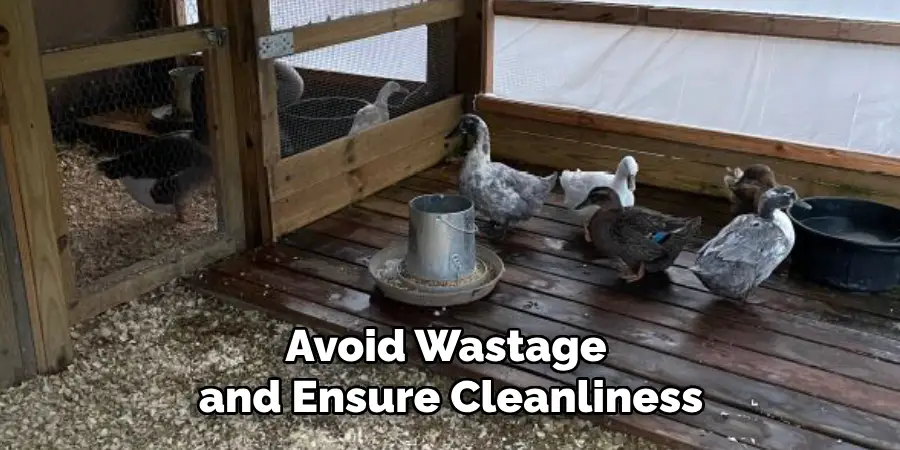
C. Supplemental Nutrition
In addition to the starter feed, offering vitamin and mineral supplements can be beneficial to support healthy growth and development. Supplements are particularly important if the commercial feed lacks certain nutrients or the goslings show signs of deficiencies.
Common supplements include vitamins A, D, and E and calcium and phosphorus for bone development. However, it’s important to consult with a veterinarian or a poultry nutritionist to determine the specific needs of your goslings and the appropriate supplementation plan.
Adhering to these nutritional guidelines ensures that goslings receive the balanced diet they require for a strong start in life. Monitoring their growth, observing their behavior, and being attentive to their dietary needs are key practices that contribute to raising healthy, vigorous goslings ready for the next stages of their development.
How to Raise Goslings: Hygiene and Cleanliness
Maintaining a clean and hygienic environment is crucial for the health and well-being of goslings. It minimizes the risk of disease and infection, promoting a healthy start during their critical early weeks.
A. Clean Bedding
The bedding in the brooding area plays a significant role in ensuring the comfort and health of goslings. To prevent moisture build-up and bacterial growth, it is essential to keep the bedding dry and clean at all times. Moisture in the bedding can create an ideal environment for harmful bacteria and parasites, which can lead to health issues among the goslings.
Regular checks multiple times a day are necessary, and the bedding should be changed whenever it becomes wet or soiled. Using absorbent materials such as straw or wood shavings helps maintain dry conditions and provides insulation, keeping the goslings warm.
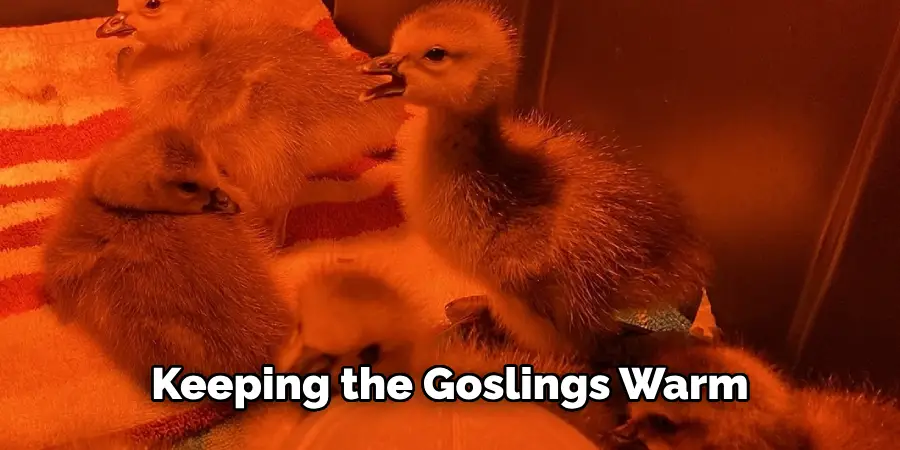
B. Water Quality
Water is vital for the survival and health of goslings, making it imperative to provide them with clean and fresh water daily. Waterers should be cleaned and refilled regularly to prevent the buildup of algae, bacteria, and contaminants that can pose a significant health risk.
It is also important to ensure that the waterers are designed to prevent goslings from soiling the water with feed or droppings, which can quickly lead to contamination. Positioning waterers in a way that minimizes spillage helpsto minimize spillage helps keepin keeping the bedding dry and reduces the risk of moisture-related issues.
C. Disease Prevention
Monitoring goslings for signs of illness or disease is critical to their care. Early detection and intervention can prevent the spread of disease and ensure the flock’s health. Symptoms such as lethargy, loss of appetite, unusual droppings, or respiratory distress should prompt immediate action, including consulting a veterinarian.
Practicing good hygiene, such as washing hands before and after handling the goslings and sanitizing equipment and brooding areas regularly, can significantly reduce the risk of disease transmission.
Limiting their exposure to wild birds and animals, which can carry diseases, is also advisable.
Adherence to these hygiene and cleanliness practices is fundamental in creating a safe and healthy environment for goslings, facilitating their growth and development into healthy adult geese.
Socialization and Behavioral Enrichment
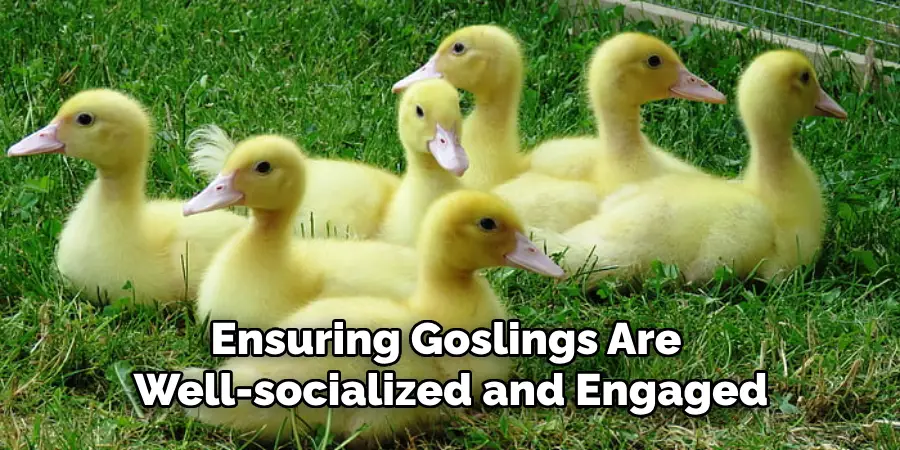
Ensuring goslings are well-socialized and engaged in their environment is crucial for their emotional and physical well-being.
A. Social Interaction
Goslings are inherently social creatures and thrive in environments where they can interact with their peers. Providing opportunities for socializing allows them to establish and understand social hierarchies, communicate effectively, and display natural behaviors.
In the early stages of life, allowing goslings to mingle and play with one another under supervision helps mimic natural flock dynamics. This interaction is essential for their development into well-adjusted adult geese capable of navigating complex social structures.
B. Environmental Enrichment
Creating a stimulating environment is key to the behavioral development of goslings. Access to outdoor areas where they can graze, forage, and explore significantly contributes to their physical health and mental stimulation.
Introducing safe exploration materials, such as branches, leaves, and even shallow water pools, can encourage natural behaviors like pecking, swimming, and searching for food. These activities enrich the goslings’ environment and aid in their muscular development and coordination.
C. Handling and Taming
Frequent and gentle handling of goslings helps familiarize them with human interaction, which is critical for managing stress and promoting a calm demeanor. From an early age, caretakers should spend time with the goslings, talking softly and handling them gently to build trust and ease.
This practice not only aids in their socialization but also makes future interactions, whether for health checks or general care, much smoother for both goslings and humans.
It’s important, however, to balance human interaction with ample time for goslings to bond with their flock mates, ensuring they grow up to be well-rounded individuals.
Adopting these practices of social interaction, environmental enrichment, and gentle handling from an early age shapes goslings’ overall health, behavior, and temperament, preparing them for a fulfilling life ahead.
Growth and Development Monitoring
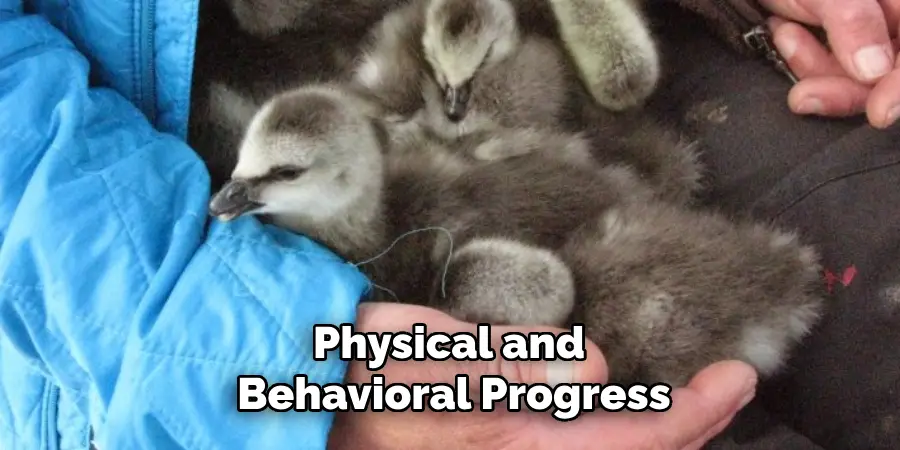
Monitoring the growth and development of goslings is essential to ensuring they thrive. This involves keen observation and record-keeping of their physical and behavioral progress throughout their early life stages.
A. Growth Tracking
Tracking the growth of goslings involves more than just monitoring their weight. It encompasses a holistic view of their development, including their feeding behavior and health status. Keeping detailed records of each gosling’s weight gain over time helps identify any abnormalities or growth issues early.
Observing their feeding behavior also gives insights into their overall health and nutritional uptake. Are they eating and digesting their food properly? Do they show a healthy appetite? These observations and regular health assessments form a comprehensive view of each gosling’s growth and development.
B. Behavioral Observation
Closely observing goslings’ behavior patterns is crucial for understanding their well-being and social development. Normal behaviors like eating, drinking, sleeping, and socializing indicate a healthy, stress-free environment.
Changes in these behaviors, conversely, can be early indicators of stress, illness, or environmental issues. Being attuned to these changes enables caretakers to adjust care practices and the environment to meet the goslings’ needs effectively.
C. Health Checks
Regular health checks are paramount in identifying and addressing potential health concerns before they become serious. These checks should include examinations for signs of distress, illness, or injury. Observing the condition of their feathers, skin, eyes, and beak can provide valuable clues about their health status.
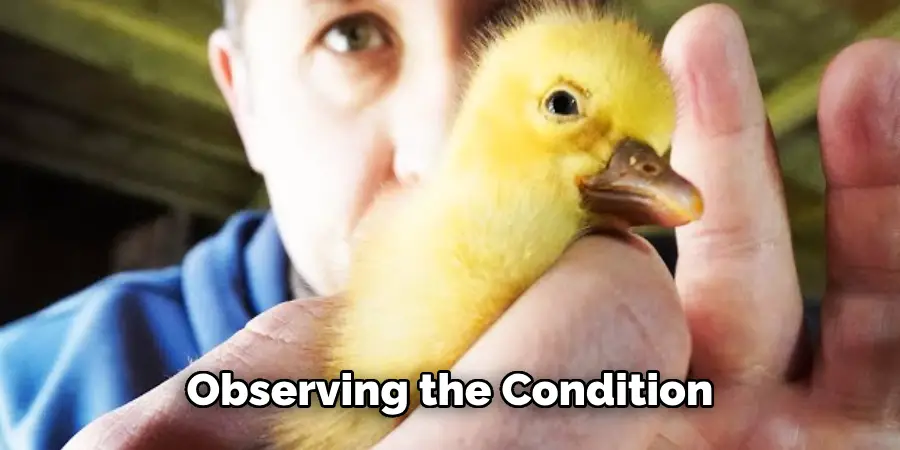
Should any health concerns arise, it is imperative to consult a veterinarian promptly. Veterinarian consultations should occur when problems are suspected and as part of a regular health maintenance routine to prevent issues before they start.
Through diligent growth tracking, behavioral observations, and regular health checks, caregivers can ensure goslings develop into healthy, strong geese, capable of thriving in their environment.
Transition to Outdoor Living
Transitioning goslings to outdoor living is a critical phase in their development, requiring careful planning and execution.
A. Gradual Transition
Goslings should be introduced to outdoor environments gradually to allow them to acclimate to natural conditions and temperature changes. Initially, short, supervised outings during warmer parts of the day can help goslings adjust to the outside world. Gradually increase the duration of outdoor time as they show signs of comfort and adaptability. This methodical approach ensures they develop the necessary resilience to weather variations and outdoor stimuli.
B. Predation Prevention
Protecting goslings from predators is paramount during their transition to outdoor living. Implementing secure fencing that is both high enough to prevent jumping predators and embedded into the ground to deter digging is essential. Utilizing predator deterrents, such as motion-activated lights or scare devices, can further safeguard the young birds. Additionally, prioritizing supervised outdoor time until goslings are fully acclimated can drastically reduce the risk of predation.
C. Continued Care
Even as goslings grow and spend more time outdoors, their need for ongoing care and support does not diminish. Continuously monitor their well-being, observing for any signs of distress, illness, or injury. Adjust their care and the outdoor environment to meet their evolving needs.
This includes ensuring they have access to shelter, clean water, nutritious food, and maintaining cleanliness and safety standards in their living areas. Through diligent observation and adaptive management practices, goslings can smoothly transition to thriving in outdoor living conditions.
Conclusion
In summary, the essential practices and considerations for raising goslings successfully encompass various care aspects. Each step plays a critical role in their overall well-being, from ensuring the right nutrition, environmental enrichment, and socialization practices to closely monitoring their growth and development and transitioning them safely to outdoor living.
It cannot be overstated how vital providing optimal care, nutrition, and a safe, enriching environment is for the healthy development of goslings. These foundational elements support their physical growth and foster a positive and stress-free upbringing, laying the groundwork for them to thrive as they mature.
We hope this guide on how to raise goslings enriches your understanding and supports your endeavors in nurturing these fascinating creatures. Raising goslings into thriving, healthy adults is a rewarding journey that requires dedication, knowledge, and a deep sense of responsibility towards these living beings. May your efforts be met with success, leading to the joy of watching your goslings grow into happy and healthy geese.

